A Feathered River Across the Sky
Air Date: Week of March 14, 2014
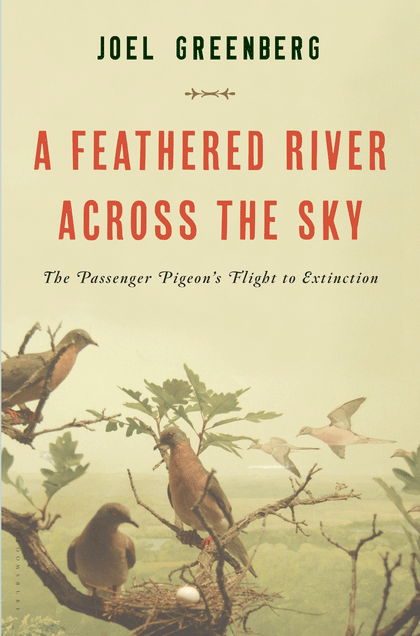
Cover photo
In the 19th century passenger pigeons numbered in the billions across North America. By 1914 they were extinct. Naturalist Joel Greenberg has written a book about the pigeon and its extinction called A Feathered River across the Sky, and he joins Steve Curwood to talk about lessons we can learn from its demise.
Transcript
CURWOOD: Well, the New World offered many other wonders besides gullible Native Americans to the first settlers. Then up to 40 percent of the continent’s birds were passenger pigeons, that travelled in flocks so massive they blocked out the sun for hours, sometimes for days. Yet the species was gone within a couple of centuries, and the very last passenger pigeon, Martha, died in the Cincinnati zoo in 1914. Joel Greenberg is the author of “A Feathered River Across the Sky, the Passenger Pigeon’s Flight To Extinction”, and he joins us now from Chicago. Welcome to Living on Earth, Joel.
GREENBERG: Well, thank you very much, Steve, it's an honor to be on your show.
CURWOOD: First of all, why did they call them passenger pigeons?
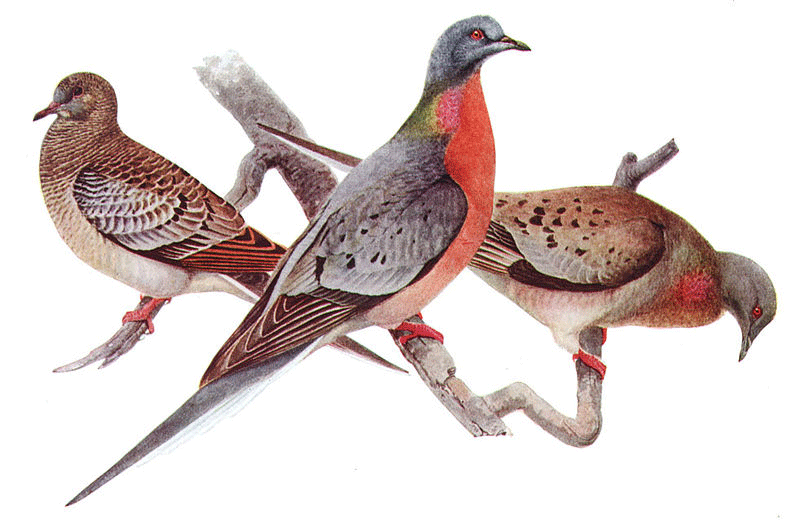
Juvenile (left), male (center), female (right), by Louis Agassiz Fuertes (public domain image)
GREENBERG: Well, it was because they were moving all the time in search of food, so they would be here today, gone tomorrow. They were birds of passage.
CURWOOD: Uh huh. What did the passenger pigeon look like?
GREENBERG: Passenger pigeons look a lot like morning doves. They were more brightly colored. They were larger by maybe one-and-a-half times. Turns out though that they’re most related to another group of pigeons, North American pigeons, the best known of which is the Band-tailed pigeon of the west.
CURWOOD: So the passenger pigeon is its own genus. It’s not even just a species.
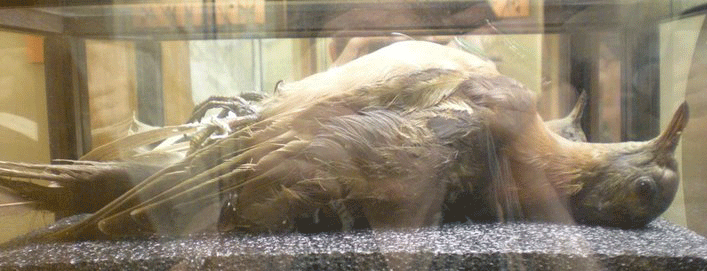
The last known wild passenger pigeon, shot by a boy in Ohio in 1900. Cincinnati Zoo. (Sarah Stierch, Wikipedia)
GREENBERG: That is correct. There were three things about the passenger pigeon that made it unlike any other bird that human beings have ever known. One, the huge population, almost certainly in the billions - the most abundant bird in North America if not the world. Secondly, that population was not evenly spread over the landscape. They would aggregate in huge, huge numbers, perhaps the largest flight ever reported was from 1860 near Toronto. Modern scientists have made some assumptions, and they believe that depending on how fast the birds were flying, there were anywhere between two billion and 3.7 billion birds. And third, despite that abundance, by 1900, just 40 years later, the bird was, for all intents and purposes, gone from the wild. 14 years after that, the last bird died in the zoo. So the rapidity with which deliberate human action wiped out a species of that population size is unprecedented.
CURWOOD: It’s hard to imagine how an animal numbering in the billions just completely disappeared over the space of less than 50 years. What exactly happened?
GREENBERG: We happened to them. They were just exploited mercilessly. With the introduction of railroads and the telegraph in the 1840s, that meant that if you were close to a railroad station, you could ship barrels of them to major urban centers, and of course, in the mid-to-late 1800s cities like New York and Chicago were growing - dramatically - so this provided cheap food. Secondly, the telegraph meant that wherever the bird showed up, that information could be disseminated very quickly. The telegraph operators were specifically instructed to share this information. There was a group of men, anywhere from 600 to 3,000, who did nothing but chase these birds wherever they were, so if they nested in Pennsylvania, they’d spend May in Pennsylvania. Then the birds would migrate away from the nesting...they’re done, they roost in Indiana. They would go hurrying to Indiana and just follow the birds. And then you have the locals who also were killing the birds for their own use as well as a way to augment their income. So these birds were being relentlessly targeted. As people went into the nesting colonies with the kind of shooting and disturbance, the birds just abandoned nesting altogether and would just say, “OK, the heck with this, I’m just leaving.” And then the collapse was rapid.
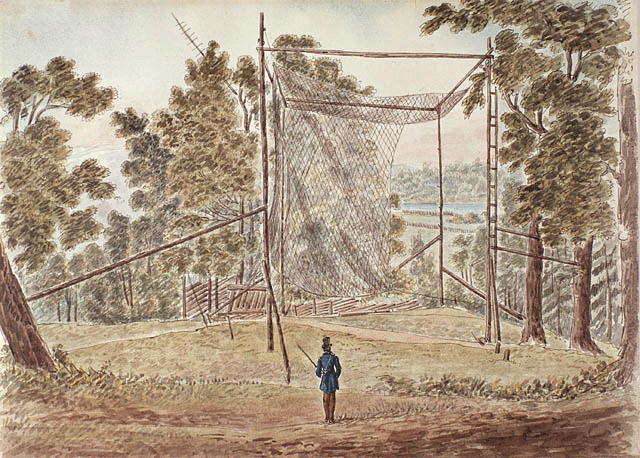
"Passenger Pigeon Net, St. Anne's, Lower Canada,” Watercolour and pen and black and brown ink on wove paper. September 20, 1829 (image: James Pattison Cockburn, public domain)
CURWOOD: What were these passenger pigeon harvests like?
GREENBERG: There were two principle ways the birds were killed. They were shot, and they were netted. The nettings were pretty elaborate affairs. But in order to attract the birds, they used two kinds of live passenger pigeon decoys. The first were known as flyers. They were tethered, and so when a flock of wild pigeons flew over, these birds were let go as the wild birds turned to take another look, they would pull in the flyers and they would then use what was known as a stool pigeon, that’s how about the term came about, one who betrays one’s own kind. Stool pigeons were attached to a stool, which was at the end of a pole. And so, the wild birds see this bird peacefully feeding, they would come down, and sometimes hundreds of birds would be caught in a single release of the net. And if there were too many birds, then you had a problem because enough of them could raise the net just a bit, so some birds could escape. So the hunters left their blinds, threw themselves onto the net to weigh it down, so they’d reach in and they’d chomp down with their jaws on the back of the pigeon’s neck. One guy complained he’d bit so many pigeons his teeth actually got loose.
CURWOOD: How tasty were these birds?
GREENBERG: Well, the literature varies, different people had different opinions. Wild birds, adults, some people said were pretty stringy, others liked them. Clearly the squabs, the babies which were fat and tender, those were the birds that were most coveted.
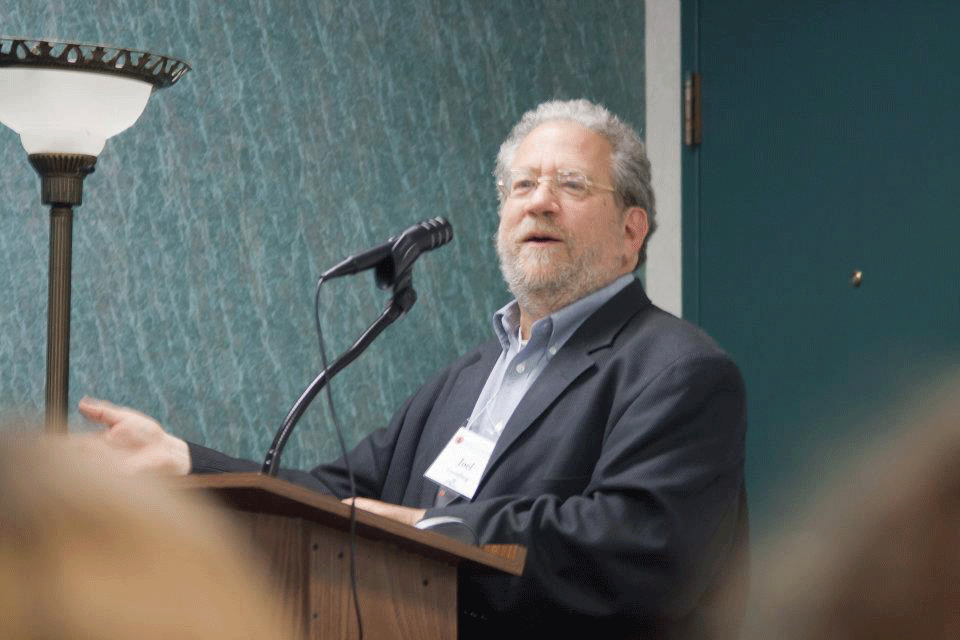
Author Joel Greenberg (photo: JoelGreenberg.com)
CURWOOD: So in the late 1800s some people begin to notice the passenger pigeons were becoming scarce. How did they explain what was happening?
GREENBERG: Different people reacted to that differently. There was an industry, and people who had a financial interest in maintaining the taking of these birds made up things like, “oh, don’t worry, the birds lay multiple eggs and they nest many times during the year.” Well, the fact is the bird only laid one egg, and they only nested once a year. The last real gathering of any size at all were a few million birds in Wisconsin and Pennsylvania in 1882 so people would say, see, there’s a big flock in Wisconsin, so don’t worry. When people are confronted with inconvenient truths, one approach is to deny it.
There were even more bizarre responses. One person wrote that the birds had all moved to Colombia, South America, lived in the jungles and changed their appearance so no one could recognize them. No, no, they moved to Arizona in the desert, like Americans seeking freedom have always done, they moved west. Once the birds were extinct, one guy was a pigeon hunter and wrote articles defending the industry. When the birds were gone, he wrote an article and he said, “yup, the birds are gone and, man, I don’t have any idea at all how this happened.”
CURWOOD: Joel, this is such a dark story. Why explore this now 100 years later? Why not just let this rest?
GREENBERG: Well, there’s a couple of responses to that. It’s a powerful cautionary tale. It shows that no matter how common something is, and that could be water, it could be fuel, or it could be something alive. If we’re not good stewards, if we’re not careful, we can lose it. And so, this message, this lesson is important to us today. I mean, there’s an analogue I think is the closest, and that’s pelagic fishing - removing all living things using these factory ships with their nets, depleting shark and tuna populations for the same reason the pigeon was wiped out.
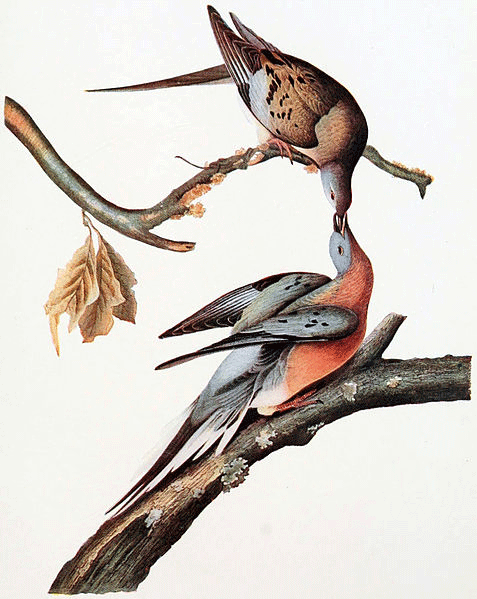
Passenger Pigeon illustration from 1907 (image: John James Audubon)
There’s no sovereign that can say, “don’t take more than a certain amount,” it’s going to require international cooperation, so I think the story bolsters international cooperation. So I think the story really bolsters the importance of conservation. And secondly, it affected 19th century culture in a way that we probably can’t appreciate today. It inspired James Fenimore Cooper. His first novel has a scene about passenger pigeons, and he sets up a conservation dilemma with different characters taking different perspectives. So, it moved people who saw this.
It still inspires people. I mean, the story is still powerful. And Steve, since 2010, I’m aware of four different novels where the pigeon is either an element of the plot or the setting for the story. So it still moves people in many ways. I think that why it’s relevant is we really have to be vigilant, and I think it behooves us, for those of us that care, you know, to live in a beautiful world that’s full of wonder and nature is vibrant, to do what we can to let the powers know that we care about this.
CURWOOD: Joel Greenberg‘s book is called “A Feathered River Across the Sky, the Passenger Pigeon’s Flight To Extinction”. Joel, thank you for taking this time with me today.
GREENBERG: Well, thank you so much, Steve. I really appreciate it.
Links
"Martha: Last Of the Passenger Pigeons," written and performed by John Herald.
Living on Earth wants to hear from you!
Living on Earth
62 Calef Highway, Suite 212
Lee, NH 03861
Telephone: 617-287-4121
E-mail: comments@loe.org
Newsletter [Click here]
Donate to Living on Earth!
Living on Earth is an independent media program and relies entirely on contributions from listeners and institutions supporting public service. Please donate now to preserve an independent environmental voice.
NewsletterLiving on Earth offers a weekly delivery of the show's rundown to your mailbox. Sign up for our newsletter today!
 Sailors For The Sea: Be the change you want to sea.
Sailors For The Sea: Be the change you want to sea.
 The Grantham Foundation for the Protection of the Environment: Committed to protecting and improving the health of the global environment.
The Grantham Foundation for the Protection of the Environment: Committed to protecting and improving the health of the global environment.
 Contribute to Living on Earth and receive, as our gift to you, an archival print of one of Mark Seth Lender's extraordinary wildlife photographs. Follow the link to see Mark's current collection of photographs.
Contribute to Living on Earth and receive, as our gift to you, an archival print of one of Mark Seth Lender's extraordinary wildlife photographs. Follow the link to see Mark's current collection of photographs.
 Buy a signed copy of Mark Seth Lender's book Smeagull the Seagull & support Living on Earth
Buy a signed copy of Mark Seth Lender's book Smeagull the Seagull & support Living on Earth

